Riot Blockchain (RIOT) Stock: Mining net loss
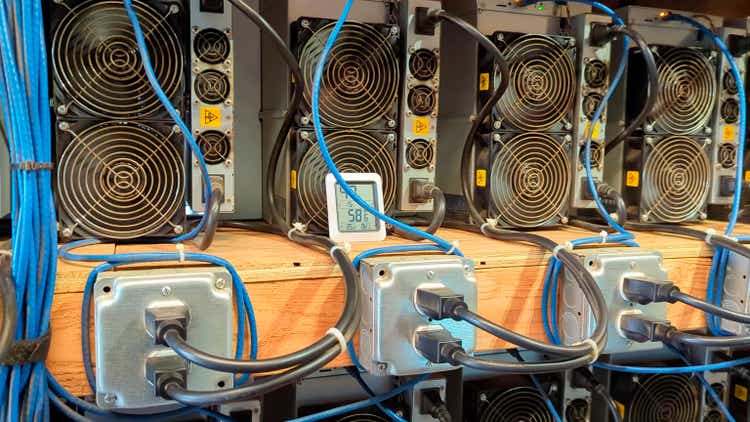
Aranga87/iStock via Getty Images
Bitcoin (BTC-USD) bears would be too hasty to dismiss Bitcoin’s demise on the back of the FTX (FTT-USD) disaster, but the collapse of the third-largest cryptocurrency exchange would be a significant setback for 13 year old cryptocurrency. FTX had a truly impressive cap table with some of the most prestigious institutional investors from Sequoia Capital to Singapore’s Temasek. Therefore, I believe the collapse of FTX is set to form a significant setback for the wider adoption of cryptocurrencies and the growth of the industry. Why wouldn’t it? 2021 was Bitcoin’s time in the sun. The price had exploded to $64,000, there were over a dozen Bitcoin-related IPOs or deSPAC transactions, and the level of institutional interest and money flowing into the ecosystem was at record levels.
Some of the Riot Blockchains (NASDAQ:RIOT) peers are now under significant financial stress. This includes North America’s largest Bitcoin miner Core Scientific (CORZ) which has indicated it may initiate Chapter 11 proceedings, Argo Blockchain (ARBK) and Iris Energy (IREN). While some bulls may flag this as a potential future opportunity for Riot Blockchain as it is a disruption to competing miners and could open up the spectrum of asset purchases at difficult prices, the underlying point remains that the Bitcoin ecosystem is collapsing in on itself as contagion from FTX -debacle continues to claim new victims. This year has already seen BlockFi, Three Arrows Capital, Alameda Research, and Voyager Digital (OTCPK:VYGVQ) all collapse. I think all of these point to a bleak future for the Colorado-based Bitcoin mining company.
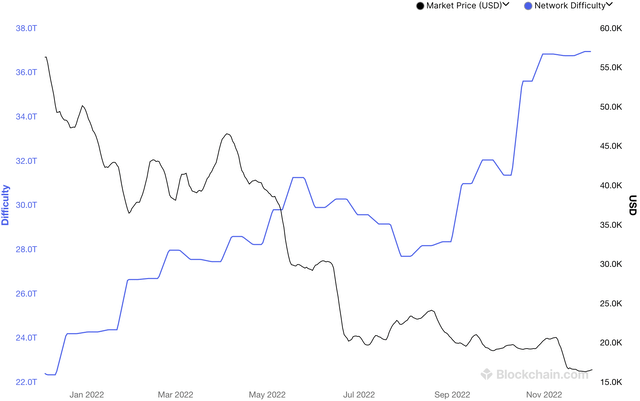
Blockchain.com
Riot Blockchain is essentially an arbitrage play on the cost of the electricity needed to power thousands of Antminer ASICs and the price of Bitcoin. While the process to start mining for gold involves prospectusing, obtaining the necessary permits and then excavating the land, Bitcoin mining describes the operation of specialized hardware and software to solve extremely complicated math problems to verify transactions on the blockchain. Miners are rewarded with new Bitcoin for their efforts.
Difficulty with mining and electricity increases as the price goes down
Riot Blockchain faces intense headwinds as mining woes mount amid Bitcoin prices down 64% year-to-date. This has come as the energy crisis from the collapse of global energy markets due to Russia’s war in Ukraine temporarily leads to an increase in electricity costs. That said, Riot Blockchain’s Bitcoin mining facilities, Rockdale and Corsicana, are both located in Texas which has some of the lowest rates in the US. Bulls would also be right to counter that the company has long-term power agreements with ERCOT that include the ability to sell power back at spot prices for credits when power use is reduced.
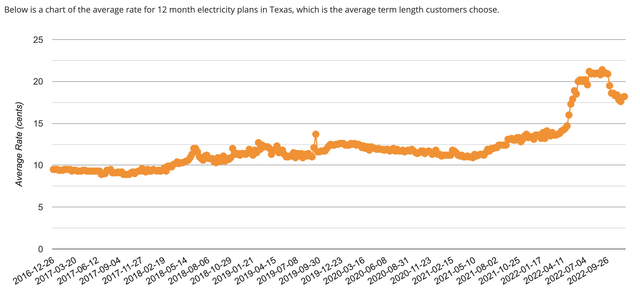
Texas Electricity Ratings
These credits are essentially one type of Energy trade instrument used to incentiveice Energy conservation and demand response. Corsicana is set to be a 1 GW facility when completed, while Rockdale has a total capacity of 750 MW, but with 450 megawatts currently developed and remaining capacity under development.

Riot Blockchain
The company last reported earnings for the third quarter of fiscal 2022, which saw revenue come in at $46.3 million, down 28.5% from the year-ago quarter and missing consensus estimates by $9.23 million on the back of lower Bitcoin prices. Riot Blockchain produced 1,042 bitcoins during the period, down from 1,292 last year as there was a curtailment in mining activity. This was partially offset by $13.1 million in power limitation credits.
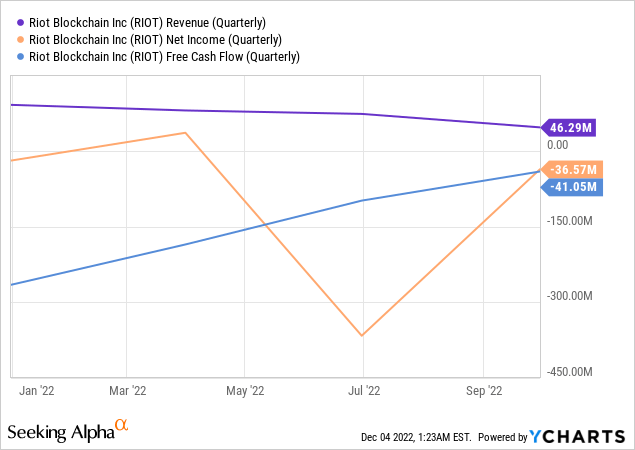
The company was unprofitable with a net loss in the quarter of $36.6 million, up from a loss of $15.3 million in the same period last year. Negative free cash flow of $41 million was driven by continued CapEx on the expansion of the Rockdale and Corsicana developments.
Rolling headwind ahead
The company has a well-capitalized balance sheet that contained cash and equivalents of $257 million at the end of the third quarter, but this has been built on the back of the significant dilution of common shareholders.
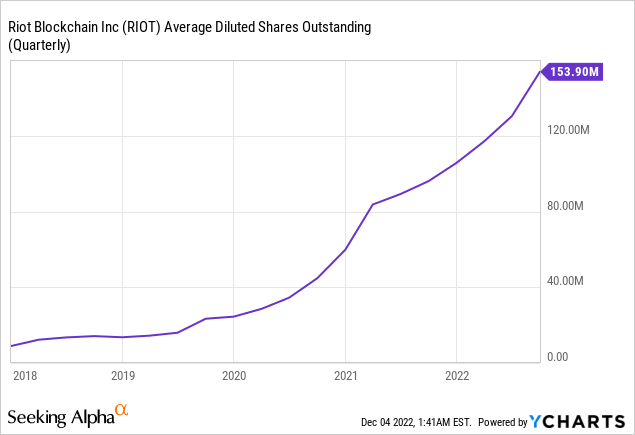
More to come with a Form 8-K recently filed with the SEC confirming that shareholders had approved an amendment to increase the number of authorized shares of common stock to 340 million shares from the current 167 million. This comes on the back of an ongoing offer of 500 million dollars on the market which started earlier this year in March. The intense dilution made sense when Bitcoin prices were low and RIOT was trading at a premium to its underlying value, but with a depressed stock price, a prolonged crypto winter, and the upcoming Bitcoin halving in May 2024, Riot Blockchain is facing intense headwinds.
The New York Bitcoin mining ban on operations primarily fueled by fossil fuels also adds to the upcoming regulatory quagmire facing the industry, as other states are likely to follow suit. Although there is a very low probability that this is mirrored by Texas, the move by New York will add to the debate about what the regulatory response to the FTX debacle should be. Greater demands for environmental sustainability may form part of the basis for future regulation that prevents access to Bitcoin for a wider public and institutions.
Basically, Riot Blockchain’s future performance, like other commodity miners, will depend on factors out of its hands. I think Bitcoin’s crypto winter will be extended with what will likely be reduced institutional participation as the FTX issue develops. Common shareholders are being diluted to own a company that is set to extract net losses for the foreseeable future as Bitcoin prices continue to slide. I rate Riot Blockchain as a sell with no short term for Bitcoin to come.


